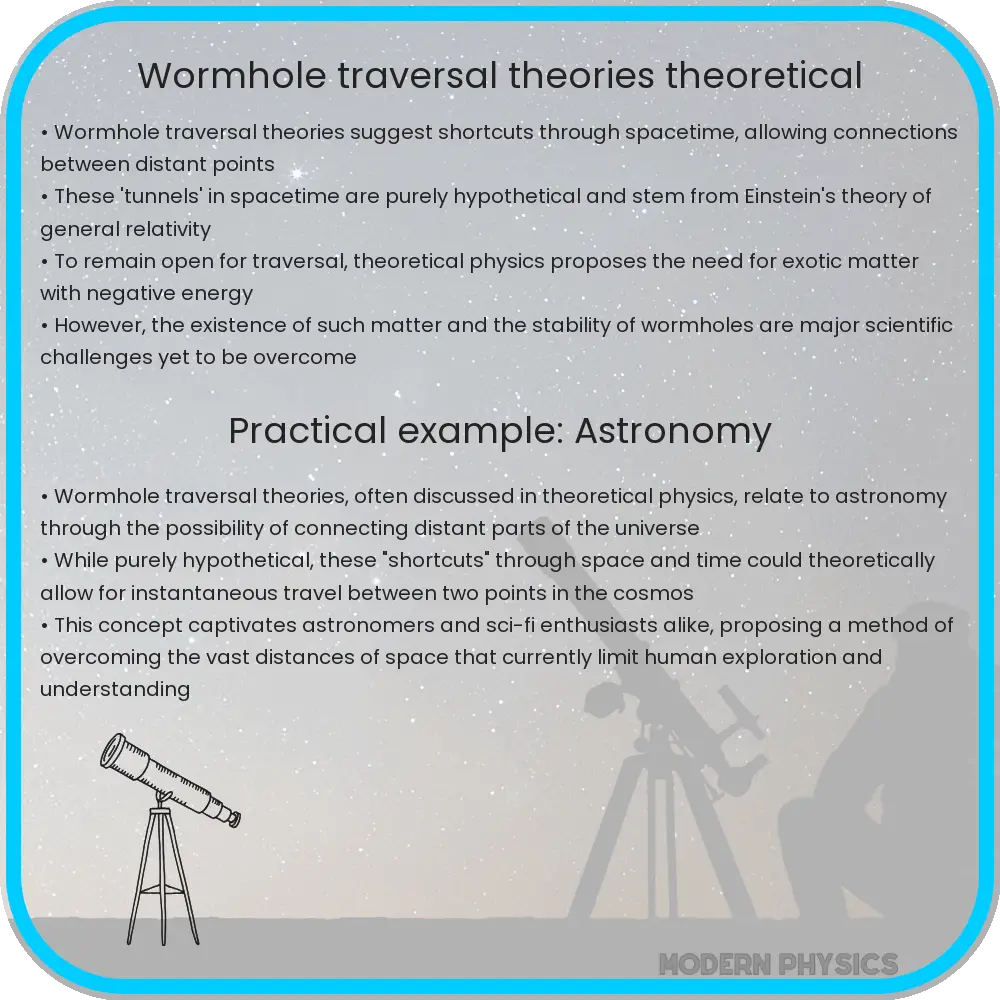Wormhole traversal involves theoretical shortcuts in space-time based on Einstein’s general relativity, connecting distant points in the universe with potential stability challenges.

Wormhole Traversal
Theory
Wormholes, also known as Einstein-Rosen bridges, are hypothetical structures in space-time that act as shortcuts connecting two distant points in the universe. The concept originates from Einstein’s theory of general relativity, which postulates that massive objects can curve space-time, creating tunnels or ‘wormholes’. Mathematically, they are solutions to the Einstein field equations.
In simple terms, imagine the universe as a two-dimensional sheet of paper. By folding this sheet, two distant points can come close together, creating a shortcut. This is the essence of how a wormhole would function in a four-dimensional universe.
Relativity
Albert Einstein’s theory of general relativity is fundamental in understanding wormholes. This theory describes gravity not as a force, but as a curvature of space-time caused by mass and energy. The Einstein field equations can be written as:
Gμν + Λgμν = (8πG/c4) Tμν
Where:
- Gμν is the Einstein tensor, representing the curvature of space-time.
- Λ is the cosmological constant.
- gμν is the metric tensor, describing the structure of space-time.
- G is the gravitational constant.
- c is the speed of light.
- Tμν is the stress-energy tensor, representing matter and energy.
Wormholes are theoretical constructs that provide specific solutions to these equations, allowing for the possibility of travel between different regions of space-time.
Space-Time
In order to understand wormholes, it’s crucial to comprehend the concept of space-time. Space-time is a four-dimensional continuum where the three dimensions of space are combined with the one dimension of time. The fabric of space-time can be distorted by mass and energy.
When discussing wormholes, several important terms come into play:
- Mouths: The two ends of a wormhole, which could be in different regions of space-time.
- Throat: The tunnel-like passage that connects the two mouths.
A significant challenge in wormhole traversal is the issue of stability. According to current theoretical models, natural wormholes would collapse quickly due to gravitational forces. Some scientists propose the use of ‘exotic matter’ with negative energy density to stabilize them, but this remains speculative.
Einstein-Rosen Bridge
The Einstein-Rosen Bridge, a specific type of wormhole, was first theorized by Albert Einstein and Nathan Rosen in 1935. Their solution to the Einstein field equations suggested a bridge connecting two black holes. The Einstein-Rosen Bridge can be described by the Schwarzschild metric, a solution to the equations representing the curvature around a spherical mass.
ds2 = - (1 - \frac{2GM}{c2r}) dt2 + (1 - \frac{2GM}{c2r})-1 dr2 + r2 dΩ2
This equation describes how distances and times are distorted by the gravitational field around a spherical object. Although the Einstein-Rosen Bridge was a groundbreaking concept, it’s not traversable because it requires more detailed theoretical constructs to allow for safe passage.
The Role of Exotic Matter
One of the most intriguing aspects of wormholes is the theoretical requirement of ‘exotic matter’ to stabilize them. Exotic matter is a form of matter with negative energy density and negative pressure, which can counteract the gravitational forces that would otherwise cause a wormhole to collapse.
To understand why exotic matter is crucial, let’s consider the mouth of a wormhole. Under normal circumstances, the gravitational forces would pull the walls of the wormhole mouth together, causing it to collapse. Exotic matter, with its unusual properties, can exert an outward pressure, balancing the inward pull and keeping the wormhole throat open.
- Negative energy density: A theoretical concept where the energy density in a region of space is less than the vacuum energy.
- Negative pressure: A pressure that counters normal gravitational forces, possibly providing the necessary repulsion to keep a wormhole stable.
While exotic matter has yet to be discovered or created in practical quantities, it remains a focal point of theoretical physics and a critical component in the quest to make wormhole travel feasible.
Wormhole Applications
If wormholes could be stabilized, they could revolutionize our understanding and exploration of the universe. Here are some potential applications:
- Interstellar Travel: Wormholes could allow for instant travel between distant stars, overcoming the limitations of speed and distance that currently hinder space exploration.
- Communication: They could enable instantaneous communication across vast distances, which would be a game-changer for missions beyond our solar system.
- Time Travel: Some theories suggest that wormholes could connect different points in time, not just space, potentially allowing for time travel.
These applications, while speculative, highlight the transformative potential of wormhole research.
Conclusion
Wormholes, or Einstein-Rosen bridges, present an exciting and complex topic within theoretical physics and cosmology. Rooted in Einstein’s theory of general relativity, wormholes offer a dramatic reimagining of space-time, suggesting the possibility of shortcuts through the universe. However, the practical challenges, including the need for exotic matter and the issue of stability, mean that wormholes remain largely theoretical. The intriguing possibilities they present, from interstellar travel to novel communication methods, continue to inspire scientists and fuel ongoing research. Understanding wormholes not only deepens our grasp of the universe but also pushes the boundaries of modern physics.
